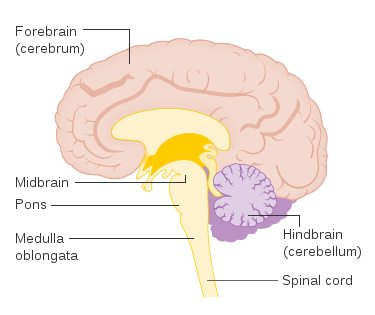Introduction to Regions of the Brain
Episode #2 of the course Introduction to clinical neuropsychology by Alicia Nortje
Welcome back to Day 2 of this course! Yesterday we learned a bit about the history of neuropsychology, but today we’ll learn more about the structure of the brain.
The Brain
Together with the spinal cord, the brain forms part of the central nervous system (CNS). The CNS is divided into grey matter and white matter, which is named after the color of the tissue. The color of the tissue is due to the parts of the nerve cells that form the grey and white matter.
The brain consists of two hemispheres: the left hemisphere and the right hemisphere. Both hemispheres have an outer grey matter layer, with white matter inside. There is a rift that lies between the hemispheres, but the two hemispheres aren’t completely separate from each other. Instead, they’re connected by a small bridge, known as the corpus callosum.
The Brain Stem
At the base of the brain, near the back, is an important structure called the brain stem. The brain stem connects to the spinal cord. The brain stem consists of four parts: the medulla oblongata, the pons, the midbrain, and the diencephalon. The brain stem is extremely important for most involuntary behavior, for example, breathing, heart rate, and consciousness. Without the brain stem, we would not be alive. The brain stem also contains two other important structures: the thalamus and the hypothalamus. The thalamus acts as the control center for the brain, and it plays an important role in synthesizing visual information, coordinating movement. The hypothalamus is integral to the limbic system, which is important for goal-directed behaviors.
The Cerebellum
Attached to the brain stem is a structure that looks like a cauliflower—this is the cerebellum. The cerebellum is important for movement. The cerebellum is also known as the little brain.
The Hemispheres
The largest parts of the brain are the hemispheres. The hemispheres contain grey matter on the outside, but there is a layer of white matter inside. The surface of the hemispheres is convoluted and is covered in sulci and gyri, which are the peaks and valleys on the surface of the brain. The positions of the sulci and gyri act as important landmarks on the brain.
One important landmark sulci are the lateral fissure. The lateral fissure helps divide each hemisphere into the following four lobes: frontal, parietal, occipital, and temporal.
The Four Lobes
The four lobes are named after the parts of the skull that they lie beneath. The frontal lobe is at the front of the brain and is placed behind the forehead. The frontal lobe is separated from the parietal lobe by the central sulci. The temporal lobe lies beneath the parietal lobe, and the two lobes are separated from each other by the lateral fissure. The fourth lobe, the occipital lobe, is positioned at the back of the brain. The cerebellum is placed beneath the temporal and occipital lobes.
Functions Linked to the Four Lobes
Each lobe has a somewhat specialized role and contains important regions, which are responsible for specific psychological processes. We’ll touch on these briefly.
• The frontal lobe is important for attention and personality. Within the frontal lobe are very important regions such as the prefrontal cortex. It is responsible for planning behavior, intelligence, and judgment (collectively known as executive functioning), as well as the motor cortex and premotor cortex, which are important for directed movement (e.g., deciding to reach for your cup of coffee). The parietal lobe plays an important part in how we understand our bodies in space. Imagine trying to touch your nose while your eyes are closed. The parietal lobe helps you do this.
• The occipital lobe houses the visual cortex and is responsible for interpreting visual stimuli.
• Auditory stimuli are processed in the temporal lobe. Within the temporal lobe is the hippocampus, which is responsible for memory and emotional aspects of human behavior, and the amygdala, which is part of the limbic system and processes feelings like fear. The olfactory tract, which processes smells, is also present in the hippocampus.
Conclusion
Phew! Today was a crash course in the basic structure of the brain. Well done! In tomorrow’s lesson, we’ll learn about different neuropsychological syndromes.
Until then,
Alicia
Recommended book
Share with friends




